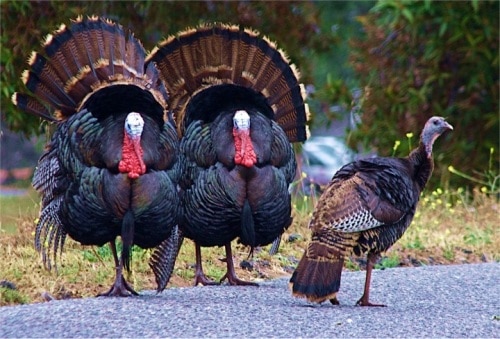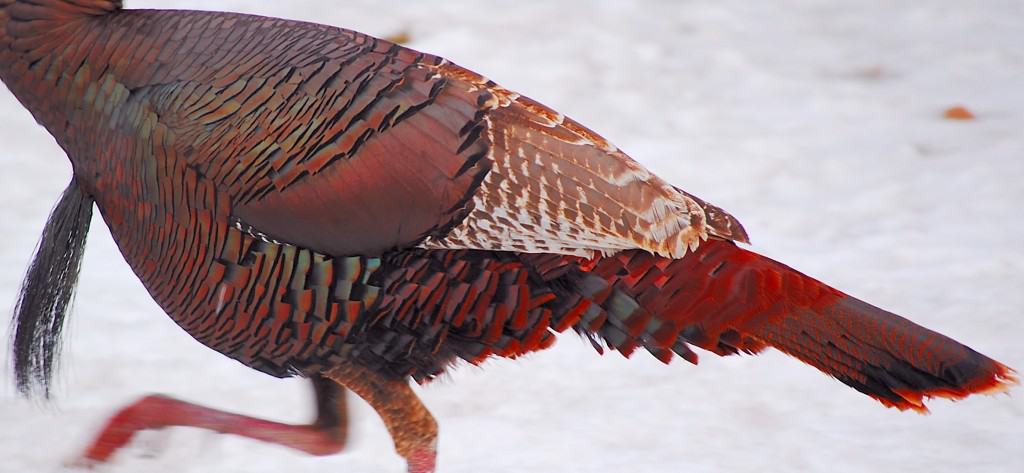I don’t know what American grade school kids are being taught these days – I left Oakville Elementary a couple of decades ago (Okay, fine—several decades ago) and since I haven’t had kids of my own I don’t have access to 21st century homework assignments. But I’ll go out on a limb here and bet that most of them know the bald eagle (Haliaeetus leucocephalus) won the 1782 version of American Idol, and that it did so by edging out celebrity judge Benjamin Franklin’s favorite, the wild turkey (Meleagris gallopavo).
That long-ago contest had little in common with the popular modern day version of the reality television show. For one thing, neither bird has great pipes. Citizens were never asked to call or text in their votes. The bald eagle has held on to national fame longer than fellow white-headed winner Taylor Hicks, and the turkey hasn’t exactly had the last laugh by, say, winning an Academy Award, Jennifer Hudson-style.
On the other hand, we don’t set aside a day each November on which the eagle takes center stage. So in honor of Thanksgiving, I’d like to briefly sing the praises of our runner-up mascot, and not just as the star entrée of a holiday dinner.

Shortly after the U.S. Congress immortalized the eagle on the Great Seal, Franklin shared his disappointment and misgivings over their choice in a letter to his daughter. Given the sparse pelt on his own pate, one might expect ol’ Ben would view the Baldy as a kindred spirit, or at least harbor a bit of sympathy. Instead, his criticism was as harsh as any doled out by Simon Cowell, describing our new symbol “a Bird of bad moral character” who “does not get his Living honestly,” preferring to sup on rotting fish or, worse yet, stealing fresh seafood from more industrious raptors like the osprey (Pandion haliaetus). What’s more, Ben argued the eagle is cowardly, evidenced by how easily it can be driven away by much smaller birds defending their nests and offspring.

The turkey, according to Franklin, is “in Comparison a much more respectable bird,” a “true original Native of America” and a “Bird of Courage” who “would not hesitate to attack” any invader and defend his home turf.
This description might not square with the image in your mind, formed over many years of hearing about dim-witted, flightless, and overwhelmingly uninspiring white domesticated Butterball turkeys. But the wild turkey is another beast entirely.
Tom turkeys (as the males are called) will most certainly defend their breeding territory against potential rivals. Large and heavy, they are unexpectedly agile flyers, aggressive fighters,relatively intelligent, and adaptive. To my knowledge they have never been accused of theft or seen dining on carrion (their omnivorous diet consists primarily of acorns and other nuts, seeds, fruit, buds and leaves, insects and the occasional small reptile or amphibian).
As far as moral character goes… well, you know rock stars. Toms strut their stuff in a flamboyant palette of iridescent red, green, purple, copper, bronze, and gold feathers worthy of Adam Lambert. No piercings or tattoos, but a beard of stiff bristles, wattles (flesh hanging from the head and/or neck), caruncles (fleshy growths on the head), snoods (long fleshy object draped across a tom’s beak), and other body art certainly make a statement. The hens, in keeping with avian fashion trends, tend to be more conservative. They are also attentive mothers to their precocialoffspring, in contrast to their menfolk, who are polygamous absentee fathers. Male bald eagles, it must be said, are actively involved in their children’s upbringing; given his own reputation, Ben might have been well served to heed the old saying about people who live in glass houses before he cast the first stone.

Like the bald eagle, wild turkeys experienced a perilous decline in their numbers—not due to DDT exposure but because of overhunting and habitat loss in the early 20th century. Game agencies took action to protect the species and were successful in helping the population to recover—so much so that turkeys have not only returned to rural fields, pastures, and woodlands, in some parts of the country spotting a flock of wild turkeys foraging near a highway, hanging out downtown, or feasting at a backyard bird feeder is no longer a novelty.
Which means a growing number of Americans now have a chance to have turkeys over to dinner more than once a year and see them at venues other than a serving platter.
For that, I am thankful.
©2012 Next-Door Nature—no reprints without written permission from the author (I’d love for you to share my work. Just ask first.). Thanks to these photographers for making their work available through a Creative Commons license: Teddy Llovet (cover);keeva999 (turkey in flight); Mic Stolz (plumage);Peter Patau (men).
Kieran Lindsey
Kieran Lindsey loves looking for wild things in all the wrong places... so she became an urban biologist. Her quest to entice others to share this passion led to flirtations with (gasp!) the media—as a columnist for the Houston Chronicle; as host of KUNM-FM’s Wild Things; as producer of an Emmy® winning wildlife documentary; and at her Next-Door Nature blog. Kieran has way too much fun as official Animal-Vehicle Biologist for NPR's Car Talk, and she isn’t ashamed to admit it.


Leave a Reply